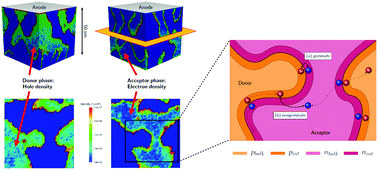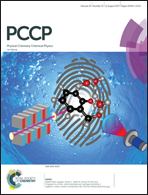Influence of permittivity and energetic disorder on the spatial charge carrier distribution and recombination in organic bulk-heterojunctions†
Abstract
In bulk-heterojunction organic solar cells the low permittivity in combination with the spatial and energetic disorder of the organic materials lead to a complex behavior of charge carriers within the active layer. Charges originate from exciton splitting at the heterojunction interface and the successive interplay between mutual Coulomb interactions and transport through the disordered organic can lead to insufficient separation from the interface, increased interface densities with respect to the bulk regions and, hence, affect recombination. To further understand the mechanisms of recombination, insight into the explicit spatial distribution of charge carriers within the blend is crucial. We performed kinetic Monte Carlo simulations on a bulk-heterojunction organic solar cell to assess the effect of Coulomb interactions and energetic disorder on the three-dimensional spatial distribution of charge carriers and highlight the correlation with both geminate and non-geminate recombination. We show that for materials with low permittivity and large energetic disorder the charge distribution is strongly inhomogeneous with accumulation along the heterojunction interface. In such cases recombination is not limited by recombination partners finding each other but rather an interface controlled process where geminate recombination dominates over nongeminate recombination.



 Please wait while we load your content...
Please wait while we load your content...